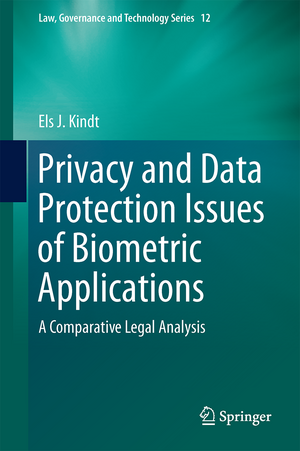Privacy and Data Protection Issues of Biometric Applications: A Comparative Legal Analysis: Law, Governance and Technology Series, cartea 12
Autor Els J. Kindten Limba Engleză Hardback – 20 dec 2013
Biometric systems use facial images, fingerprints, iris and/or voice in an automated way to identify or to verify (identity) claims of persons. The treatise which has an interdisciplinary approach starts with explaining the functioning of biometric systems in general terms for non-specialists. It continues with a description of the legal nature of biometric data and makes a comparison with DNA and biological material and the regulation thereof. After describing the risks, the work further reviews the opinions of data protection authorities in relation to biometric systems and current and future (EU) law. A detailed legal comparative analysis is made of the situation in Belgium, France and the Netherlands.
The author concludes with an evaluation of the proportionality principle and the application of data protection law to biometric data processing operations, mainly in the private sector. Pleading for more safeguards in legislation, the author makes several suggestions for a regulatory framework aiming at reducing the risks of biometric systems. They include limitations to the collection and storage of biometric data as well as technical measures, which could influence the proportionality of the processing.
The text is supported by several figures and tables providing a summary ofparticular points of the discussion. The book also uses the 2012 biometric vocabulary adopted by ISO and contains an extensive bibliography and literature sources.
| Toate formatele și edițiile | Preț | Express |
|---|---|---|
| Paperback (1) | 1685.58 lei 6-8 săpt. | |
| SPRINGER NETHERLANDS – 23 aug 2016 | 1685.58 lei 6-8 săpt. | |
| Hardback (1) | 1692.20 lei 6-8 săpt. | |
| SPRINGER NETHERLANDS – 20 dec 2013 | 1692.20 lei 6-8 săpt. |
Din seria Law, Governance and Technology Series
- 18%
 Preț: 950.33 lei
Preț: 950.33 lei - 24%
 Preț: 645.13 lei
Preț: 645.13 lei - 20%
 Preț: 691.10 lei
Preț: 691.10 lei - 20%
 Preț: 574.08 lei
Preț: 574.08 lei - 20%
 Preț: 879.83 lei
Preț: 879.83 lei - 20%
 Preț: 878.78 lei
Preț: 878.78 lei - 15%
 Preț: 720.23 lei
Preț: 720.23 lei - 18%
 Preț: 1122.56 lei
Preț: 1122.56 lei - 18%
 Preț: 1130.27 lei
Preț: 1130.27 lei - 15%
 Preț: 642.83 lei
Preț: 642.83 lei - 18%
 Preț: 950.52 lei
Preț: 950.52 lei - 18%
 Preț: 1009.85 lei
Preț: 1009.85 lei - 18%
 Preț: 1115.14 lei
Preț: 1115.14 lei - 15%
 Preț: 653.14 lei
Preț: 653.14 lei - 18%
 Preț: 949.23 lei
Preț: 949.23 lei - 18%
 Preț: 1014.76 lei
Preț: 1014.76 lei - 15%
 Preț: 638.43 lei
Preț: 638.43 lei - 18%
 Preț: 1124.30 lei
Preț: 1124.30 lei - 18%
 Preț: 1124.60 lei
Preț: 1124.60 lei - 18%
 Preț: 999.45 lei
Preț: 999.45 lei - 18%
 Preț: 892.42 lei
Preț: 892.42 lei - 15%
 Preț: 640.37 lei
Preț: 640.37 lei - 18%
 Preț: 947.35 lei
Preț: 947.35 lei - 20%
 Preț: 340.32 lei
Preț: 340.32 lei - 18%
 Preț: 954.93 lei
Preț: 954.93 lei - 24%
 Preț: 789.37 lei
Preț: 789.37 lei -
 Preț: 397.59 lei
Preț: 397.59 lei - 20%
 Preț: 876.60 lei
Preț: 876.60 lei - 20%
 Preț: 652.41 lei
Preț: 652.41 lei - 18%
 Preț: 900.49 lei
Preț: 900.49 lei - 18%
 Preț: 941.50 lei
Preț: 941.50 lei -
 Preț: 392.97 lei
Preț: 392.97 lei
Preț: 1692.20 lei
Preț vechi: 2063.66 lei
-18% Nou
Puncte Express: 2538
Preț estimativ în valută:
323.84€ • 351.64$ • 272.03£
323.84€ • 351.64$ • 272.03£
Carte tipărită la comandă
Livrare economică 22 aprilie-06 mai
Preluare comenzi: 021 569.72.76
Specificații
ISBN-13: 9789400775213
ISBN-10: 9400775210
Pagini: 895
Ilustrații: XXI, 975 p. 11 illus.
Dimensiuni: 155 x 235 x 63 mm
Greutate: 1.56 kg
Ediția:2013
Editura: SPRINGER NETHERLANDS
Colecția Springer
Seria Law, Governance and Technology Series
Locul publicării:Dordrecht, Netherlands
ISBN-10: 9400775210
Pagini: 895
Ilustrații: XXI, 975 p. 11 illus.
Dimensiuni: 155 x 235 x 63 mm
Greutate: 1.56 kg
Ediția:2013
Editura: SPRINGER NETHERLANDS
Colecția Springer
Seria Law, Governance and Technology Series
Locul publicării:Dordrecht, Netherlands
Public țintă
ResearchCuprins
Preface; Peter Hustinx.- Acknowledgements.- Acronyms.- Table of Contents.- Introduction.- Part I: The Concept Of Biometric Data.- Chapter 1. An Introduction Into The Use Of Biometric Technology.- Section I. A Long History of Use of Biometric Characteristics.- Section II. The Functioning Of A Biometric System.- Chapter 2. Biometric Data, Data Protection and the Right To Privacy.- Section I. Biometric Data and the Concept of Personal Data.- Section II. Biological Material and Other Information Relating To Individuals.- Section III. Biometric Data, Data Protection and Privacy.- Chapter 6. Strengths and Weaknesses Of The Proportionality Principle For Biometric Applications.- Part III: Assessment and Recommendations For Strengthening The Data Protection Framework For Biometric Data.- Chapter 7. The Criteria For The Correct ‘Balancing Of Rights’.- Chapter 8. The Need For A Consistent Legal Regulation Of Biometric Data.- Chapter 9. A Legal Model For The Use Of Biometric Data In The Private Sector.- List Of Figures And Tables.- Bibliography.- Index.
Recenzii
From the book reviews:
“This book on privacy and data protection issues of biometric applications has been published as part of the Springer ‘Law, Governance, and Technology’ series. … The book includes an extensive bibliography and a helpful index. It is well written and exhaustive. … This worthy, interesting book is a must for those involved in bringing about new legislation concerning safeguarding privacy while employing biometric systems.” (S. V. Nagaraj, Computing Reviews, July, 2014)
“This book on privacy and data protection issues of biometric applications has been published as part of the Springer ‘Law, Governance, and Technology’ series. … The book includes an extensive bibliography and a helpful index. It is well written and exhaustive. … This worthy, interesting book is a must for those involved in bringing about new legislation concerning safeguarding privacy while employing biometric systems.” (S. V. Nagaraj, Computing Reviews, July, 2014)
Textul de pe ultima copertă
This book discusses all critical privacy and data protection aspects of biometric systems from a legal perspective. It contains a systematic and complete analysis of the many issues raised by these systems based on examples worldwide and provides several recommendations for a transnational regulatory framework. An appropriate legal framework is in most countries not yet in place.
Biometric systems use facial images, fingerprints, iris and/or voice in an automated way to identify or to verify (identity) claims of persons. The treatise which has an interdisciplinary approach starts with explaining the functioning of biometric systems in general terms for non-specialists. It continues with a description of the legal nature of biometric data and makes a comparison with DNA and biological material and the regulation thereof. After describing the risks, the work further reviews the opinions of data protection authorities in relation to biometric systems and current and future (EU) law. A detailed legal comparative analysis is made of the situation in Belgium, France and the Netherlands.
The author concludes with an evaluation of the proportionality principle and the application of data protection law to biometric data processing operations, mainly in the private sector. Pleading for more safeguards in legislation, the author makes several suggestions for a regulatory framework aiming at reducing the risks of biometric systems. They include limitations to the collection and storage of biometric data as well as technical measures, which could influence the proportionality of the processing.
The text is supported by several figures and tables providing a summary ofparticular points of the discussion. The book also uses the 2012 biometric vocabulary adopted by ISO and contains an extensive bibliography and literature sources.
Biometric systems use facial images, fingerprints, iris and/or voice in an automated way to identify or to verify (identity) claims of persons. The treatise which has an interdisciplinary approach starts with explaining the functioning of biometric systems in general terms for non-specialists. It continues with a description of the legal nature of biometric data and makes a comparison with DNA and biological material and the regulation thereof. After describing the risks, the work further reviews the opinions of data protection authorities in relation to biometric systems and current and future (EU) law. A detailed legal comparative analysis is made of the situation in Belgium, France and the Netherlands.
The author concludes with an evaluation of the proportionality principle and the application of data protection law to biometric data processing operations, mainly in the private sector. Pleading for more safeguards in legislation, the author makes several suggestions for a regulatory framework aiming at reducing the risks of biometric systems. They include limitations to the collection and storage of biometric data as well as technical measures, which could influence the proportionality of the processing.
The text is supported by several figures and tables providing a summary ofparticular points of the discussion. The book also uses the 2012 biometric vocabulary adopted by ISO and contains an extensive bibliography and literature sources.
Caracteristici
Presents the first complete legal analysis of privacy and data protection issues related to biometric data processing Provides a comprehensive overview and critical discussion of existing regulation of biometric data processing in Belgium, France and the Netherlands Detailed analysis of existing trends in privacy and data protection regulation applied to biometric data processing Includes supplementary material: sn.pub/extras
















